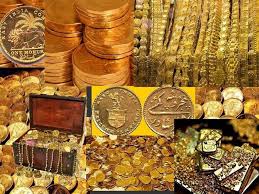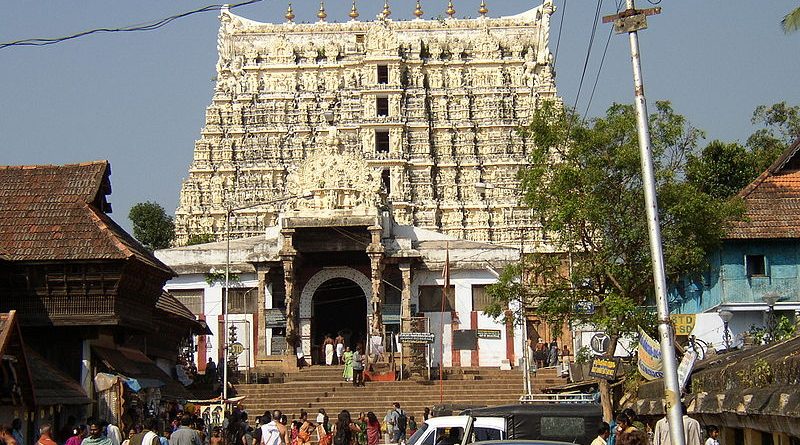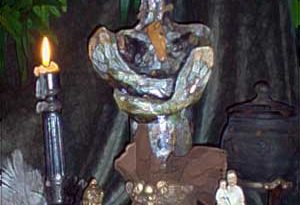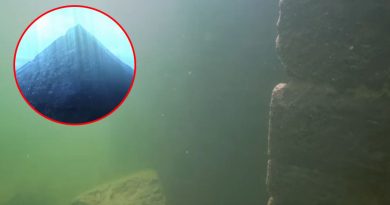Hidden Treasure of Padmanabhaswamy Temple
On June 2011 a hidden treasure which included antique gold ornaments, diamonds, golden crown, golden bow, golden vessels, and other precious stones were found in the secret chambers (Nilavara in temple) of Sree Padmanabhaswamy Temple in Thiruvananthapuram, Kerala. Unofficial estimates say that the treasure discovered so far over four days of inspections may be valued at more than 25 billion rupees ($500m). But historians say that assessing the true value of these objects is likely to be extremely difficult. The local rulers sealed immense riches within the thick stone walls and secret vaults of the temple, over at least a millennium, as offerings to Lord Padmanabhan.
Sree (Sri) Padmanabhaswamy temple is known for its architectural elegance and long rows of granite columns with exquisite engravings, have Lord Vishnu reclining on the multiple-headed serpent Anantha as the presiding deity. This temple is one of the famous Hindu temple dedicated to god Vishnu maintained by the erstwhile Travancore Royal Family and located inside East Fort in the city of Thiruvananthapuram, Kerala state, South India. The temple is considered to be one of 108 Divya Desams (Holy Abodes), which are principal centres of worship in Vaishnavism. The date of the temple is unknown, but the temple is mentioned in the ancient writings of the Alwars (6th-9th centuries AD), and renovations are thought to have taken place until the 18th century. Lord Padmanabhaswamy is enshrined here in Anananthasayanam posture (in eternal sleep of yognidra). The main idol inside the sanctum sanctorum and viewed from three doors is in the reclining posture.

The local legend tell the story of Sage Vilvamangalam’s first darshan of Lord Vishnu as Padmanabha who crashed upon his path as a tree before revealing himself as the infinite power. Praised by Anantha, the five headed serpent, the Lord was persuaded by the sage to stay in the city. His massive form reclining on the heads of Anantha, is believed to have extended and exactly covered the area that was to be Thiruvananthapuram. Marthandavarma, the well known Maharaja of Travancore (note that the state of Kerala was formed by the integration of 3 princely states – Travancore, Kochi and Malabar) dedicated his Kingdom to Sree Padmanabhaswami with the capital at Padmanabhapuram in the south. His successor Maharaja Ramavarma in 1795 shifted the capital to the present city of Thiruvanathapuram. In spite of its political importance it is really heartening to see this wonderful city retaining its original charm and continues to hold all it’s rich heritage in tact. The roads and buildings here are grander than the other Kerala Cities. This city boasts even of connections with King Solomon, whose ships said to have landed in a mysterious place called Ophir.
Traders were said to have been coming here as far back as 190 AD for spices, ivory, etc.Since Independence, the temple has been controlled by a trust run by the descendants of the Travancore royal family. After 1947 the kingdom of Travancore merged with the princely state of Cochin, which eventually became the present-day state of Kerala. The members of the Travancore royal family consider themselves to be servants of the presiding deity at the temple, Padmanabhaswamy, which is an aspect of the Hindu God Vishnu in eternal sleep. This is why they historically entrusted their wealth to the temple.
But there was a public outcry when the Maharajah attempted to retain control of the temple by citing the special law, with many arguing that the wealth belonged to the people now.The vaults were opened in the presence of the panel, and observers, which include high court judges, temple officials, archaeology authorities, Sundar Rajan and a representative of the current Maharajah.On Thursday (June 30, 2011), the team assisted by personnel from the fire services and archeology department opened the locks of vault A to find a narrow flight of stairs leading down to an underground granite cellar. Oxygen was pumped frequently into the chamber and artificial lighting provided to enable the observers to work inside. What they saw inside was startling, sources said. Gold coins dating back thousands of years, gold necklaces as long as nine feet and weighing about 2.5 kg, about one tonne of the yellow metal in the shape of rice trinkets, sticks made of the yellow metal, sack full of diamonds, gold ropes, thousands of pieces of antique jewellery studded with diamonds and emeralds, crowns and other precious stones lay scattered in the chamber marked ‘A’.
On the next day they found far more surprises in the form of 17 kg of gold coins dating back to the East India Company period, 18 coins from Napolean’s era, precious stones wrapped in silk bundles besides over 1,000 kg of gold in the form of coins and trinkets and a small elephant made of the yellow metal, sources said. There were also sovereigns bearing the 1772 seal indicating they were from the reign of the then native king Karthika Thirunal Rama Varma. There are a total of six vaults marked A to F in the shrine. The A and B cellars have never opened since 1872.On July 2, 2011, approximately 500 billion rupees ($11.2 billion US) worth of gold, jewels, and other treasures were unearthed in the vaults of the temple. Several antiques such as 18th century Napoleonic era coins were also discovered at the temple. Finds also included a golden idol of Mahavishnu and ceremonial attire for adorning the deity in the form of 16-part golden anki weighing almost 30 kilograms as well as golden coconut shells, one studded with rubies and emeralds. India’s Supreme Court recently ordered the temple be managed by the State to ensure the security of the temple and its treasures.
It was then revealed that after opening nearly 70 percent of the secret chamber; gold, gold coins, gold chains, diamonds, crowns and necklaces, amongst other items, worth more than 90,000 crore (US$20.07 billion) was found. It is estimated that the value of the total monumental items are over 100,000 crore (US$22.3 billion) , making it the richest temple in the world.Temple sources say the treasures found in the temple included offerings made by devotees, wealth the erstwhile Travancore rulers stored in the temple and gifts and offerings received from erstwhile kings of neighbouring states.
Noted historian Dr. M. G. S. Narayanan, said people from far and near have been visiting the Padmanabhaswamy Temple since it is one of the biggest Vaishnava temples in the country. The shrine dating back to 9th Century would be having several centuries old precious objects and the inventory has been thought to have been in the temple for more than a hundred years after being collected from various places and put there by the maharajahs of Travancore. It was called “Sri Pandaram” and the items were known as “Sri Pandaram Vaka” (Lord’s Treasure).The archaeology team believed they were stored as part contingency planning and disaster recovery by the royal family. The underground chambers in the temple were chosen to protect them from British. Is it possible that the treasure trove of gold, diamonds and precious stones were brought to this temple from Ophir?
The treasure is thought to have been in the temple for more than one hundred years, having been put there by traders, pilgrims and royals such as the maharajahs of Travancore. While some Historians have suggested that a major chunk of the stored riches reached the kings in the form of tax, gift and bribes, as well as looted wealth of conquered states and temples stocked in the temple for safekeeping.[20] A ferry transported traders, pilgrims and chroniclers from the Tenavaram temple, the famously wealthy Vishnu-Shiva temple town and Tamil emporium to the Chera and Chola kingdoms of Tamilakkam via Puttalam on the western shore of Ceylon (then an extension of Malabar and the Hindu Jaffna kingdom) and the Gulf of Mannar during the medieval period. This temple was destroyed in 1587 CE, a few years after the Thiruvananthapuram Padmanabhaswamy temple gopuram was constructed. Morrocan traveller Ibn Batuta visited Tenavaram in the 14th century and described the Vishnu idol here as being made of gold and the size of a man with two large rubies as eyes “that lit up like lanterns during the night.”[ All people living within the vicinity of the temple and who visited it were fed with monetary endowments that were made to the idol.
The findings represent the highest valued assets at present, saved in secret chambers by the royal families.
The temple has 6 vaults (Kallaras), labeled as A to F for book keeping purpose by the Court, that are hidden under the sanctum sanctorum. While vaults A and B have been unopened over the past 130 years, vaults C to F have been opened from time to time. The two priests of the temple, the ‘Periya Nambi’ and the ‘Thekkedom Nambi’, are the custodians of the four vaults, C to F, which are opened periodically. The Supreme Court had directed that “the existing practices, procedures and rituals” of the temple be followed while opening vaults C to F and using the articles inside. Vaults A and B shall be opened only for the purpose of making an inventory of the articles and then closed.
On July 4, 2011 the seven-member expert team which is taking stock of the assets at temple decided to postpone opening of the secret chamber marked ‘B’ till they obtained more expert opinion as preliminary examination of its gates had found the vault to be secured with iron shutters making experts wonder what lay inside. The royal family said that many legends were attached to the temple and that chamber B has a model of a snake on the main door and opening it could be a bad omen. Seven-member team will consult with some more experts on July 8, 2011 and a then they may take the final decision on opening of chamber B.
There had been an earlier inventory of at least one vault on Sunday, December 6, 1931. A vault was opened in the presence of Sree Chithira Thirunal Balarama Varma, then the Maharaja of the state of Travancore. Among the contents found were gold and silver coins stored in a “granary like thing,” four brass chests of coins, over 300 gold pots, and a six-chambered wooden chest containing jewels decorated with diamonds, rubies, emeralds and other precious stones. Four coffers were removed and taken to the palace treasury for counting and valuation.
Source : http://www.toptenz.net/top-10-best-ghost-photographs.php



